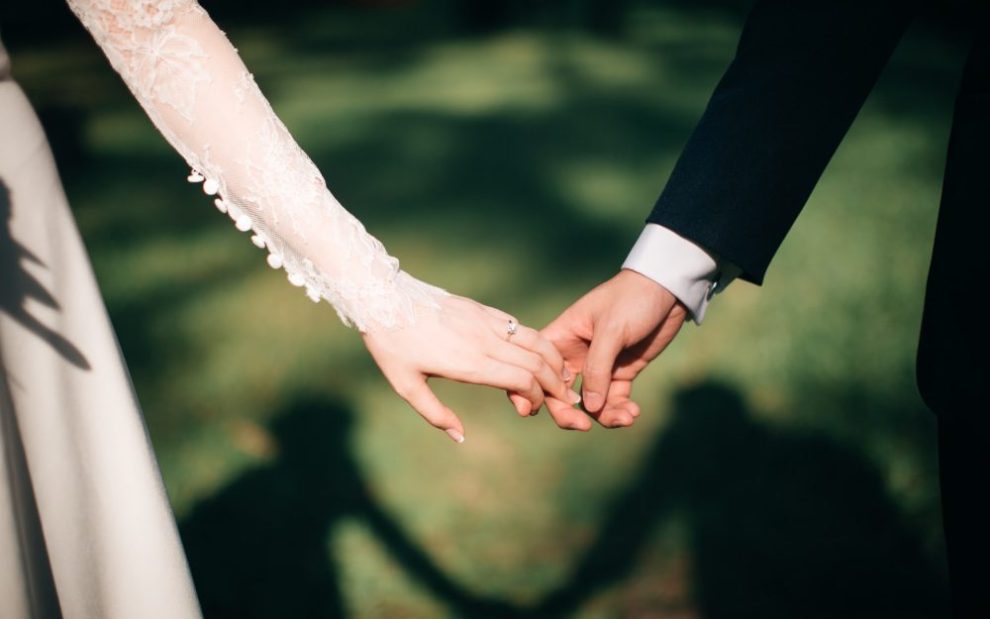Before Juliann Richards met Neal Levy, she didn’t doubt that she’d marry a fellow Catholic someday. After all, Richards was raised Catholic, attended Catholic school, grew up mostly around fellow Catholics, and knew she wanted her children raised with the same faith.
“For many years, I told myself (and others) that I was going to the nearby Catholic college so I could meet a nice Catholic boy and get married,” Richards recalls.
But when she met Levy—who is Jewish—the two quickly became friends and eventually started dating. Fast-forward several years: Richards and Levy, both 27, are newlyweds who married in a Jewish-Catholic ceremony.
Such marriages—interfaith (between a Catholic and a non-Christian) and interchurch (between a Catholic and another Christian)—have been on the rise for the past 30 years.
In fact, a 2007 survey on marriage by the Center for Applied Research in the Apostolate (CARA) revealed that marrying another Catholic is a low priority for young Catholics. Of never-married Catholics, only 7 percent said it was “very important” to marry someone of the same faith.
“We realize that this is a major pastoral issue,” says Sheila Garcia, associate director of the U.S. Conference of Catholic Bishops’ Secretariat on Laity, Marriage, Family Life, and Youth.
Good foundation
Garcia says that while supporting these couples pastorally, the church also is concerned with making sure the Catholic in a mixed-religion marriage continues to practice his or her faith and that the couple takes seriously the Catholic party’s pledge to raise their children Catholic.
Despite these challenges, Garcia believes that mixed marriages offer an opportunity for “peace and understanding, and, where possible, unity.”
“The Catholic Church is moving towards how to support the interchurch/interfaith couple,” Garcia says. “Mixed religion couples can live out Christ’s call to be one.”
One of the landmark changes in how the church approaches interfaith and interchurch engaged couples came with the 1983 revision to the Code of Canon Law, around the same time many of the millennials getting married today were born. Before the revision, the non-Catholic party had to sign a document saying they agreed that their children would be raised Catholic. Post-revision, the Catholic spouse pledges to maintain his or her faith and “to do all in her or his power so that all offspring are baptized and brought up in the Catholic Church.” The non-Catholic is informed of that pledge.
“We’ve changed quite a bit of stuff since Vatican II,” says Claretian Father Greg Kenny. “I don’t think allegiance to one church or one faith should keep you from the most basic command, that you should love one another.”
Kenny says the way the Catholic Church should deal with the growing number of interfaith marriages is on a grassroots level, one couple at a time, with parish and diocesan programs.
“If we can get across to people that religion is not getting in the way, that religion is there to help, that makes so much more sense to me,” he says. “Marriage preparation becomes a possible moment of grace.”
A nice Catholic boy
Despite the rise in interfaith and interchurch marriages, they’re not at an all-time high. According to CARA, the highest rate of interfaith marriages took place in the 1970s and 1980s, when young Catholics dispersed from East Coast and Midwestern cities into areas of the country where there were fewer Catholic enclaves.
But as Ohio couple Richards and Levy illustrate, attraction and love can trump proximity to potential partners of the same faith. While Richards’ Ohio hometown has three Catholic churches and a majority Christian populace, once she met Levy all her plans for a “nice Catholic boy” disappeared.
As they dated, the two made sure big issues like how their children would be raised or what religious traditions were important to them were discussed respectfully and resolved early on without either forgoing their faith.
When the two decided to get married, the prospect of planning for a Jewish-Catholic ceremony and, more importantly, a marriage got easier when they found an understanding priest, Father David Bline, pastor of St. Francis de Sales Parish in Akron, Ohio. Bline had worked with Rabbi Susan Stone on another interfaith marriage and put the couple in touch with her.
Richards and Levy went through both Catholic and Jewish pre-marital counseling and were surprised at how “refreshingly similar” the advice they received from both sides was. “It was good to know that the same things were being asked of us,” Richards says.
They plan to raise their children Catholic, but they both say their kids will be well aware of their Jewish heritage, and they were encouraged to raise them as such by Bline.
Respect for both of their beliefs extended into their wedding ceremony, which was led by both the priest and the rabbi. There were readings from the Hebrew scriptures and the New Testament, signing of an interfaith ketubah (a Jewish marriage contract), drinking from a kiddush cup, and the couple stood under a chuppah, or canopy during the ceremony. All the ceremony components were explained to guests in an extensive program.
Richards and Levy say being rasised in “very open and accepting families,” has helped support them throughout their relationship.
Family conflict
Things went differently for Midwesterners Sarah and Mike Miles (not their real names), who were surprised at just how much tension their own Jewish-Catholic union churned up in Mike’s family.
This is Sarah’s second marriage. In her first, which lasted about three years, she married a fellow Jew. “It was important for me to marry someone Jewish at that time,” she says, adding that her mother was also a big advocate of marrying someone of the same faith.
Mike was raised Catholic, in what he calls a “very religious family.” He went to a Catholic school and attends Mass regularly.
“When I started dating and when I met Sarah, religion wasn’t a factor,” he says. “I wasn’t marrying someone because of her religion. I was marrying Sarah because she was who she was.”
When they got engaged, both Sarah and Mike took interfaith marriage preparation classes, which helped with tough discussions they had about raising kids, celebrating holidays, and dealing with family dynamics.
The classes suggested they pick one religion for their future children. “We chose Judaism early on because it was the root of all Christianity, and there was nothing in my religion that Mike couldn’t understand,” Sarah says.
It wasn’t until after they were married and the topic of children came up that Mike’s parents voiced their disagreement with how their grandchildren would be raised. They also complained that the Jewish traditions had overshadowed the Catholic traditions at the Miles’ wedding.
Sarah and Mike decided to go to an interfaith marriage counselor and tried to talk with Mike’s parents. But face-to-face conversations, letters, and phone calls didn’t seem to help.
Several years later, Sarah and Mike have a distant relationship with Mike’s parents. But the difficulties have only brought them closer, they say.
“We’d like [his parents] to be a part of [our lives], and we welcome that opportunity, but only if we can get these issues resolved.”
Ecumenical glue
Even with a common Christian background, interchurch couples have issues to resolve in order to make their marriages work. For Lena and Luke Glover, the bond that holds their marriage together goes beyond Sunday church services. Lena, 35, is Catholic, and Luke, 34, is a nondenominational Christian.
When the two were first married there were tensions, such as when they would attend Mass together and Luke couldn’t receive communion, including at their own nuptial Mass. “It highlights our divisions,” Luke says.
What helped the Glovers find common ground was the ecumenical charismatic group People of Praise. “It’s kind of the glue for our marriage,” Luke says. “It focuses on the similarities of our life together.”
“It gives us something to do together as a family and as a couple that’s kind of bigger than church,” Lena says. “If we went round and round about our differences we would spend all our time arguing!”
The couple believes that the differences they have in faith aren’t major but that the things they do hold in common, such as their belief in Christ and the gospel, are.
“Now I wouldn’t want to change [our religions] for the world,” Lena says. “It doesn’t bother me anymore because I feel like we experience a level of ecumenism more acutely than those couples that are of the same denomination, and I’m so grateful for that.”
The couple now lives in Portland, Oregon and has four children, ages 11, 9, 6, and 5, all of whom are being raised Catholic. For a while the Glovers would attend both a Catholic and a Protestant service on Sundays plus the People of Praise community meetings. But being in church all day was difficult with young kids. Luke decided he’d choose going to Mass with the family.
“We do raise them Catholic, but we give that a little caveat and say we are raising them in a very ecumenical home,” Lena says.
Their older two kids are asking more questions now, like why Luke doesn’t take communion—he receives a blessing—or why some people pray the rosary. “We teach that there are Christians that emphasize different things,” Lena says.
She’s proud that her children are learning about different denominations. In fact, the Glovers wish they’d hear more about ecumenism at Mass. “As you educate yourself as a Catholic and dig deeper, you find out that there’s been a lot said, especially in the last 30 years, on ecumenism,” Lena says.
The USCCB’s Sheila Garcia says that ecumenical and interfaith couples are the grassroots version of what the Catholic Church hopes to accomplish in its ecumenical and interfaith statements, dialogues, conferences, and outreach.
“What these couples are living out in their own lives is what these dialogues are trying to accomplish,” Garcia says.
One family table
No matter how much interchurch couples such as the Glovers work toward unity, there’s a clear and highly visible sign of their disunity—communion.
Bonnie Mack, who works for the Archdiocese of Cincinnati’s Marriage and Family Life Office, says, “For nearly every Catholic-Protestant couple that I’ve talked to, there is pain from not receiving communion together.
“There are some who would say, ‘I don’t think Jesus would do that. I think he’d call anyone forward.’ ”
And in fact she has seen some young couples from the marriage preparation classes she teaches go up and receive communion together despite one not being Catholic. “Their way of handling church teachings is much different today,” she says. “It’s no big deal to them.”
Over the years she’s seen pastors try to balance the pastoral side and the church-teaching side of the issue. One pastor who has long dealt with the issue is Claretian Father Kenny. He has worked with interfaith and interchurch couples in the Northeast and now at his present assignment in the South as pastor emeritus of Corpus Christi Parish in Stone Mountain, Georgia.
Kenny says that in his area interchurch marriages are very common since Catholics are only the third largest denomination in the region, outnumbered by Baptists and Methodists.
“What I now explain is why the church is so stringent on that issue. There needs to be unity of worship, unity of belief, of dogma, and unity of conduct and morality to receive communion.”
But he adds, “If you could say that this was the only way to get the spiritual nourishment you seek, follow your conscience. I can’t tell you not to follow your conscience.”
Sometimes what begins as an interchurch relationship ends with one person joining the Catholic Church. Matt and Jessica Williams are one such couple who found their faith backgrounds coming together even before they were married. Jessica, 32, was baptized Lutheran but was not raised practicing that faith.
Jessica first met Matt, 43, through a mutual friend. About three or four months into their relationship, Matt, a cradle Catholic, invited Jessica to attend Mass with him at his parish, St. Margaret Mary in Winter Park, Florida.
“It really helped strengthen our relationship . . . to go to church together,” Matt says. “It was just a very important part of the week for us.”
He also recalls being surprised when, a few months into going to church together, Jessica turned to him and said, “All you have to do is ask me to convert.”
Matt says he’d been careful not to put any pressure on her, but was delighted. Jessica enrolled in RCIA, where the director, Dominican Sister Rosemary Finnegan, double-checked that, as Jessica puts it, “Your heart was in it, and that you were not just converting because it was ‘the right thing to do.’ ”
When the pair married in 2010, two months after Jessica became Catholic, it was at a Mass at St. Margaret Mary. The Williamses say that a mutual Catholic faith has served as a strong base when they face challenges.
“It’s nice to have that extra support system in place,” Jessica says. And as they look into the future at having kids, she says she’s happy that they won’t be one of those families she’d observed at church with an absentee or non-Catholic parent.
“I wanted our kids to grow up being raised in the faith, praying with them, and trying to educate them on the faith wherever we can,” Jessica says.
Matt says he never felt “locked into” the idea of marrying another Catholic. “But now that it’s a reality, it’s very important to me,” he says. “And looking back, maybe it’s more important than I realized.”
Belief differences
It’s one thing for a couple to come from a common Christian background, or to at least share a religious foundation, but Bonnie Mack says it’s another thing when one person has no faith.
“One, you can’t draw on commonalities, and two, those couples tend to drift away from church altogether,” she says.
Christie and Peter Wood disagree. The 27-year-old couple met while attending the University of Maryland. They dated for four years before Peter proposed while stargazing in Christie’s backyard. They married in 2010, at Peter’s home parish, St. Paul in Damascus, Maryland.
Christie was raised Methodist but now considers herself an agnostic. Peter describes himself as a “pretty hard-core” Catholic.
The newlyweds’ marriage parallels Peter’s parents’ relationship. Peter’s dad was raised Methodist but didn’t practice his faith as an adult, and Peter’s mom is Catholic. His father was active in helping out with church and community projects and never converted to Catholicism.
“My dad showed me that it really matters more that you walk the walk as opposed to talk the talk,” Peter says. “I was able to see that a marriage like that could work. I have a good model and good support in my parents.”
Christie says that when they began dating, she found Peter’s faith appealing. “I kind of admired it actually. I felt it was a lot of who he is,” she says. “It was that level of dedication [to his faith] that was impressive, and it was also obvious to me that his faith is what made him such a good person. I could see that reflected in his everyday actions.
“We have the same morals. We still agree on most issues and how we run our life,” Christie adds.
The Woods admit that it will be more difficult once they have kids and want to send a consistent message to them about religion.
“The most difficult thing will probably be when our [child] starts asking questions, but before they’re old enough to understand that Peter and I have different views,” she says. “For example, I’m sure the question of, ‘Why doesn’t mommy go to church?’ will come up. It’s a complicated answer that Peter and I understand, but one that will be trickier to explain to a little child.”
However, Peter adds, “I feel like it would be a lot more challenging if we had different religious perspectives that were competing with one another or trying to steal time from each other.”
Sheila Garcia notes that even Catholics who marry Catholics often have faith differences. A regular Mass-goer in a relationship with a twice-a-year Catholic is “practically a mixed marriage in and of itself,” she says.
What’s key, Garcia believes, is that every couple has to address and explore the differences in their religious beliefs because the issues won’t resolve themselves. And diocesan and parish programs should support them in their faith explorations.
This article appeared in the December 2011 issue of U.S. Catholic (Vol. 76, No. 12, page 12-17).
Image: Unsplash cc via Andrew Itaga















Add comment